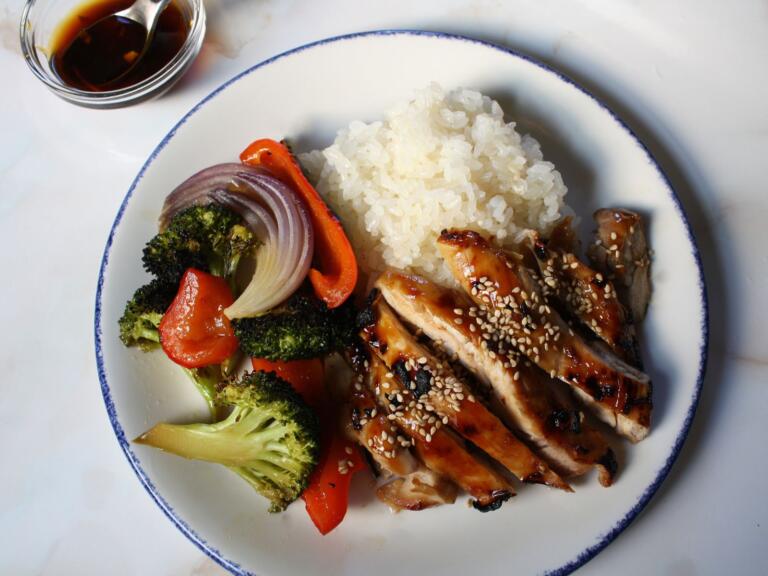Growing up in Seattle, our Friday night menu was nearly the same every week: chicken soup, roast chicken slathered in teriyaki sauce, a starchy side and salad. We always had a large bottle of Yoshida teriyaki sauce in the fridge, a fixture in the side door. But why were we eating teriyaki chicken for Shabbat dinner?
Teriyaki chicken is an iconic Seattle dish; it wasn’t until I moved away that I discovered not every city is teeming with great teriyaki shops. The dish is rooted in Japanese cuisine: Teriyaki is a traditional Japanese style of cooking where a protein is cooked over a flame while it is basted in a sauce made of soy sauce, sugar, sake and/or mirin. “Yaki” means grill, and “teri” means shine. The sticky, sweet teriyaki sauce most Americans are familiar with was developed by Japanese American immigrants.
Seattle’s version of teriyaki deviates from its Japanese roots thanks to a man named Toshihiro Kasahara. In 1976, Kasahara opened Toshi’s Teriyaki Restaurant, which quickly became a wildly successful Seattle lunch spot. Kasahara inspired a wave of teriyaki establishments across the city and the region, helping make the dish ubiquitous in the Pacific Northwest. Seattle-style teriyaki is loaded with ginger and garlic, and instead of basting the meat, teriyaki is more often made by marinating the meat in sauce overnight. It’s typically served with steamed rice and an iceberg lettuce salad with gingery, tangy dressing. The store-bought sauce my family used was also developed by a Seattle resident, Kyoto-born Junki Yoshida.
Food in the diaspora is always influenced by our neighbors, and teriyaki has become a welcome staple in Jewish homes, particularly across the Pacific Northwest. This recipe is designed to give you all the flavors and char that great teriyaki chicken offers, with the ease of preparing a complete meal on a sheet pan. The sauce is salty, thick, gingery and sweet, and as the chicken cooks, it releases its juices and flavors to the surrounding vegetables. You can substitute homemade sauce for your favorite premade bottle, and you can ditch the oven and cook this on the grill for extra char. Served with a steaming heap of short grain rice, it makes a delicious, simple meal for Shabbat, or any day of the week.
The Nosher celebrates the traditions and recipes that have brought Jews together for centuries. Donate today to keep The Nosher's stories and recipes accessible to all.
Notes:
- You can swap drumsticks for chicken thighs, but if you would like to swap for boneless, skinless breasts the cook time may be slightly longer.
- The dish reheats well in the microwave, stovetop or oven.
Sheet Pan Teriyaki Chicken
Food in the diaspora is always influenced by our neighbors, and teriyaki is beloved in many Seattle Jewish homes.
- Total Time: 55 minutes
- Yield: Serves 4
Ingredients
For the teriyaki sauce:
- 1 cup soy sauce
- ⅓ cup mirin
- ⅓ cup brown sugar
- 4 cloves garlic, minced
- 1–2 Tbsp fresh ginger, minced fine
- 1 Tbsp cornstarch + 1 ½ Tbsp water
For the chicken:
- 2 lb boneless, skinless chicken thighs
- 1 head broccoli (about 1 lb)
- 1 red onion
- 1 large bell pepper
- oil, as needed
- salt and pepper, as needed
- sesame seeds, for garnish
Instructions
- For the teriyaki sauce, whisk together the soy sauce, mirin, brown sugar, garlic and ginger.
- Add the chicken to a bowl or container, pour ¾ cups of the teriyaki sauce (about half) over the chicken — reserve the remaining ¾ cup of sauce. Allow the chicken to marinate for at least 20 minutes while you preheat the oven and prep the remaining ingredients. Alternatively, you can cover the chicken and marinate it in the refrigerator for several hours or overnight.
- Preheat the oven to 400°F. Line a sheet pan with parchment, foil or a silicone baking mat.
- Cut your broccoli into even-sized florets, about 2-3” in size. Slice your onion into thick 1” wedges. Slice the bell pepper into thick 2” wedges. Transfer the vegetables onto the baking sheet, drizzle with oil and lightly season with salt and pepper; you do not need a lot of seasoning as the teriyaki sauce is salty. Toss the vegetables until evenly coated in the oil.
- Place the marinated chicken on top of the vegetables. Cook in the oven for 20-22 minutes, or until the chicken is almost fully cooked (about 150°F).
- While the chicken is cooking, in a small bowl or cup combine the cornstarch and water. Add the remaining teriyaki sauce to a small pot. Bring the sauce up to a simmer, add the cornstarch slurry and let it thicken and cook for 2-3 minutes.
- Remove the chicken from the oven and turn on the oven’s broiler. Brush each piece of chicken with thickened sauce. Broil the chicken and vegetables for 2-3 minutes, or until the chicken is slightly charred on top. Keep an eye on your chicken so that it does not burn.
- Slice the chicken thighs, top with sesame seeds and drizzle on any remaining teriyaki sauce over the top, if desired.
Notes
- You can swap drumsticks for chicken thighs, but if you would like to swap for boneless, skinless breasts the cook time may be slightly longer.
- The dish reheats well in the microwave, stovetop or oven.
- Prep Time: 30 minutes
- Cook Time: 25 minutes
- Category: Dinner
- Method: Roasting
- Cuisine: Basics





Excellent! Thank you.
what can I subsitute for the soy sauce so that dish is not salty
Hi Muriel, you could use low sodium soy sauce. Enjoy!
I would leave the soy sauce out.
can I create a substitute homemade sauce for the mirin in the recipe given the expensive cost of mirin in the supermarket?
Hi Sharon, you could mix vinegar (preferably rice wine, if you have it) with sugar or fruit juice. Enjoy!
I cannot use ginger as it has a bad effect on me. What can I use as a substitute?
You can leave it out!
I made this recipe. It is delicious, and will be going into my regular rotation. Not only is it easy to make, but it can be adapted to whatever veggies I have on hand.
Is it really necessary to slice the chicken thighs?
My comment should be that Worcestershire is ok for Gluten sensitivity.
A you add white miso paste for cream flavor. If so what amount would you suggest?
Can you add white miso paste to the sauce?
Sure!